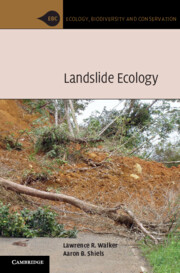5 - Biotic interactions and temporal patterns
Published online by Cambridge University Press: 05 January 2013
Summary
Key points
Landslide succession is the sequential replacement of plant communities following landslide creation. It is affected by biotic interactions and abiotic conditions and occurs in the intervals between recurrent erosion events.
Plant species can facilitate or inhibit landslide succession by direct species interactions or indirectly by the alteration of resources including light levels, soil stability, soil moisture, or soil nutrients. Species replacements may also occur due to differences in the life histories of landslide colonizers.
Herbivores, pathogens, and non-native species influence landslide succession and contribute to the variety of successional trajectories found on landslides, potentially with long-term consequences.
Landslides contribute to temporal heterogeneity of landscapes through their destruction and creation of habitats and sharp physical gradients. This heterogeneity generally has a net positive effect on biodiversity at landscape scales, but landslides generally decrease biodiversity at local scales.
Introduction
As soon as organisms colonize new landslide surfaces, they begin to alter the environment, often in ways that are not favorable for continued establishment of additional individuals of the same species. When changes in the landslide environment favor a new set of species better adapted to the changing conditions, species replacements occur. This process is considered succession (i.e., the change of ecological communities in structure and composition through time) (Glenn-Lewin et al., 1992). Primary succession occurs on surfaces where a disturbance has left little or no biological legacy (e.g., new volcanic surfaces); secondary succession occurs where soils remain relatively intact (e.g., following logging). Landslides are generally categorized as examples of primary succession because the initial disturbance removes most of the soil and vegetation (Walker & del Moral, 2003). However, because landslides frequently contain remnants of pre-disturbance soils and plants, change on those remnants often occurs along a continuum of disturbance severity between primary and secondary succession (Vitousek & Walker, 1987).
- Type
- Chapter
- Information
- Landslide Ecology , pp. 138 - 180Publisher: Cambridge University PressPrint publication year: 2012

